ignition PONTIAC GRAND-AM 1994 User Guide
[x] Cancel search | Manufacturer: PONTIAC, Model Year: 1994, Model line: GRAND-AM, Model: PONTIAC GRAND-AM 1994Pages: 274, PDF Size: 15.01 MB
Page 57 of 274
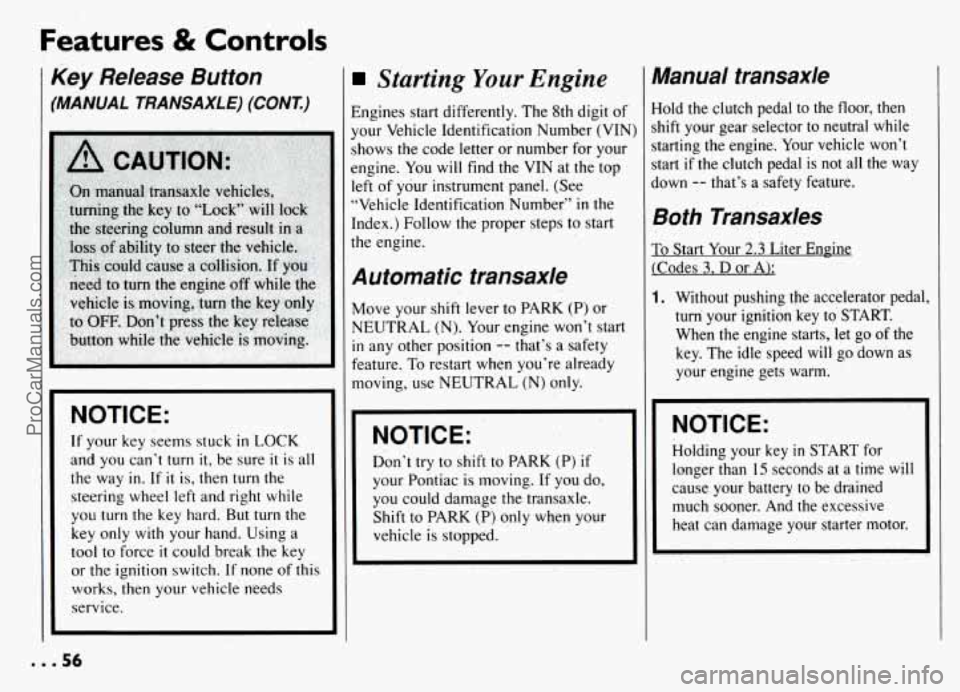
Features & Controls
Key Release Button
(MANUAL TRANSAXLE) (CONT.)
NOTICE:
If your key seems stuck in LOCK
and you can’t turn it, be sure it is all
the.way in. If
it is, then turn the
steering wheel left and right while
you
turn the key hard. But turn the
key only
with your hand. Using a
tool to force
it could break the key
or the ignition switch.
If none of this
works, then your vehicle needs
service.
Starting Your Engine
Engines start differently. The 8th digit of
your Vehicle Identification Number (VIN)
shows
the code letter or number for your
engine. You
will find the VIN at the top
left
of your instrument panel. (See
”Vehicle Identification Number”
in the
Index.) Follow the proper steps to start
the engine.
Automatic transaxle
Move your shift lever to PARK (P) or
NEUTRAL (N). Your engine won’t start
in any other position -- that’s a safety
feature. To restart when you’re already
.EUTRAL (N) only.
Don’t try to shift to PARK (P) if
your Pontiac is moving. If you do,
you could damage the transaxle.
Shift to PARK (P) only when your
vehicle
is stopped.
Manual transaxle
Hold the clutch pedal to the floor, then
shift your gear selector to neutral while
starting the engine. Your vehicle won’t
start
if the clutch pedal is not all the way
down
-- that’s a safety feature.
Both Transaxles
To Start Your 2.3 Liter EnEine
(Codes
3. D or A):
1. Without pushing the accelerator pedal,
turn your ignition key to START.
When the engine starts, let
go of the
key. The idle speed
will go down as
your engine gets warm.
NOTICE:
Holding your key in START for
longer than
15 seconds at a time will
cause your battery to be drained
much sooner. And the excessive
heat can damage your starter motor.
ProCarManuals.com
Page 58 of 274
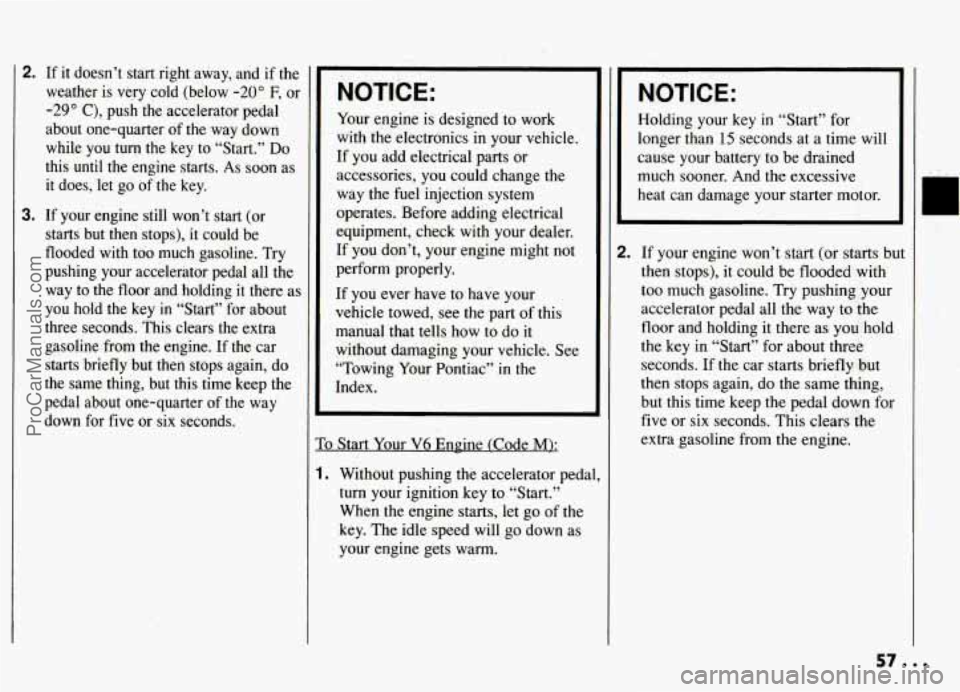
2. If it doesn’t start right away, and if the
weather is very cold (below
-20” F, or
-29” C), push the accelerator pedal
about one-quarter of
the way down
while you
turn the key to “Start.” Do
this until the engine starts. As soon as
it does, let go of the key.
3. If your engine still won’t start (or
starts but then stops), it could be
flooded with too much gasoline. Try
pushing your accelerator pedal all the
way to the floor and holding it there as
you hold the key
in “Start”.for about
three seconds. This clears the extra
gasoline from
the engine. If the car
starts briefly but then stops again, do
the same thing, but this time keep the
pedal
about one-quarter of the way
down for five or six seconds.
NOTICE:
Your engine is designed to work
with the electronics in your vehicle.
If you add electrical parts or
accessories, you could change the
way the fuel injection system
operates. Before adding electrical
equipment, check with your dealer.
If you don’t, your engine might not
perform properly.
If you ever have to have your
vehicle towed, see the part of this
manual that tells how to do it
without damaging your vehicle. See
“Towing Your Pontiac”
in the
Index.
To Start Your V6 Engine (Code M):
1. Without pushing the accelerator pedal,
turn your ignition key to “Start.”
When the engine starts, let
go of the
key. The idle speed will go down as
your engine gets warm.
NOTICE:
Holding your key in “Start” for
longer than
15 seconds at a time will
cause your battery to
be drained
much sooner. And the excessive
heat can damage your starter motor.
. If your engine won’t start (or starts but
then stops), it could be flooded with
too much gasoline. Try pushing your
accelerator pedal all the way
to the
floor and holding it there as you hold
the key
in “Start” for about three
seconds. If the car starts briefly but
then stops again, do the same thing,
but this time keep the pedal down for
five or six seconds. This clears the
extra gasoline from the engine.
ProCarManuals.com
Page 62 of 274
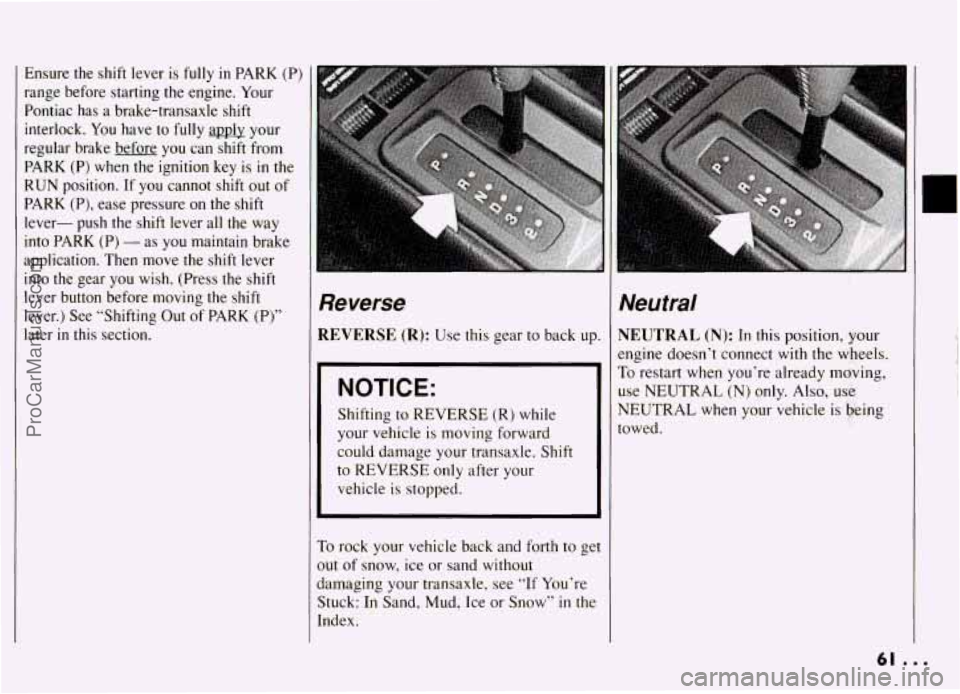
Ensure the shift lever is fully in PARK (P)
range before starting the engine. Your
Pontiac has a brake-transaxle shift
interlock.
You have to fully apply your
regular brake before you can shift from
PARK (P) when the ignition key is in the
RUN position. If you cannot shift out of
PARK (P), ease pressure on
the shift
lever- push the shift lever all the way
into PARK (P)
- as you maintain brake
application. Then move
the shift lever
into the gear you wish. (Press the shift
lever button before moving the shift
lever.) See “Shifting
Out of PARK (P)”
later
in this section.
I
Reverse
REVERSE (R): Use this gear to back up.
NOTICE:
Shifting to REVERSE (R) while
your vehicle is moving forward
could damage your transaxle. Shift
to REVERSE only after your
vehicle is stopped.
To rock your vehicle back and forth to get
out of snow, ice or sand without
damaging your transaxle, see “If You’re
Stuck: In Sand, Mud, Ice or Snow” in the
Index.
Neutral
NEUTRAL (N): In this position,,your
engine doesn’t connect with the wheels.
To restart when you’re already moving,
use NEUTRAL
(N) only. Also, use
NEUTRAL when your vehicle is Geing
towed.
61 ...
ProCarManuals.com
Page 67 of 274
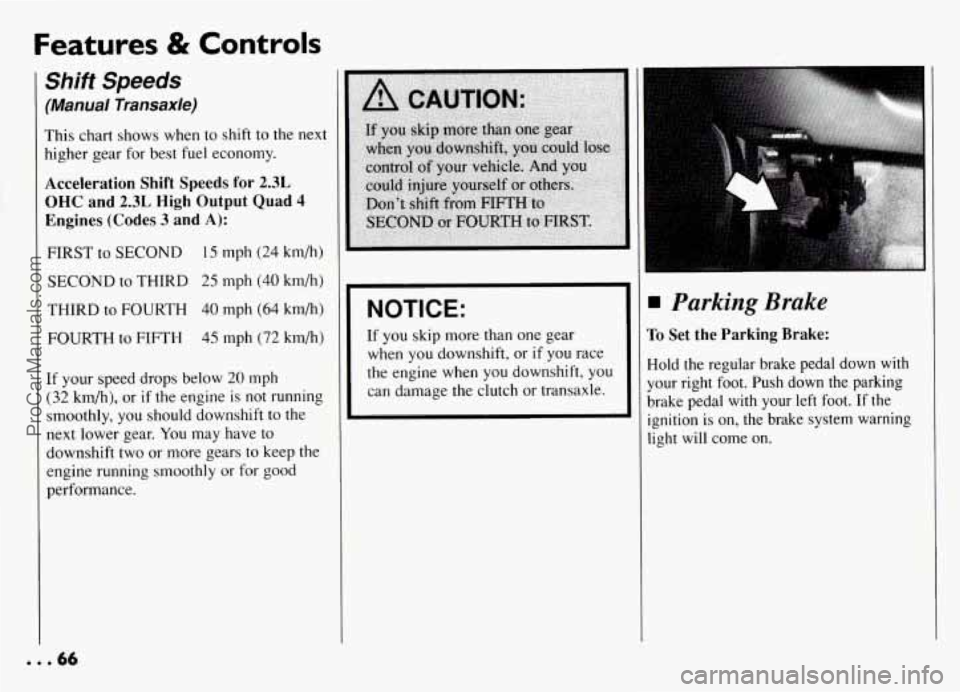
Features & Controls
Shift Speeds
(Manual Transaxle)
This chart shows when to shift to the next
higher gear for best fuel economy.
Acceleration Shift Speeds for 2.3L
OHC and 2.3L High Output Quad 4
Engines (Codes 3 and A):
FIRST to SECOND 15 mph (24 km/h)
SECOND to THIRD
25 mph (40 km/h)
THIRD to FOURTH 40 mph
(64 km/h)
FOURTH to FIFTH 45 mph (72 km/h)
If your speed drops below 20 mph
(32 km/h), or if the engine is not running
smoothly, you should downshift to the
next lower gear.
You may have to
downshift two or more gears to keep the
engine running smoothly or for good
performance.
NOTICE:
If you skip more than one gear
when you downshift, or if you race
the engine when you downshift, you
can damage the clutch or transaxle.
Parking Brake
To Set the Parking Brake:
Hold the regular brake pedal down with
your right foot. Push down the parking
brake pedal with your left foot. If the
ignition is on, the brake system warning
light will come on.
... 66
ProCarManuals.com
Page 69 of 274
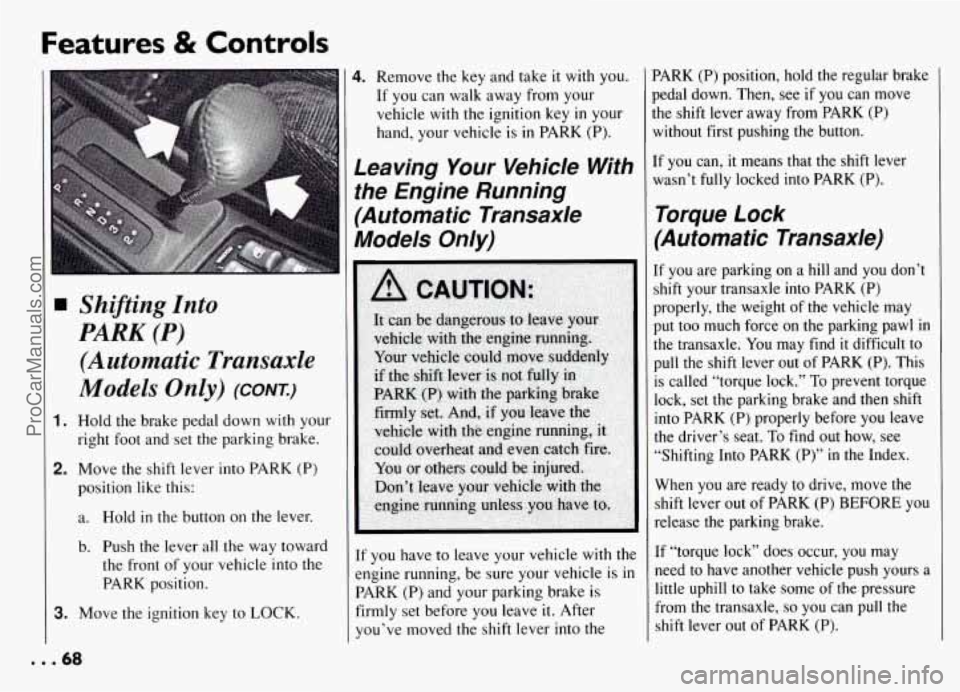
Features & Controls
T
Shifting Into
PARK (P)
(Automatic Transaxle
Models Only) (cow)
1. Hold the brake pedal down with your
right foot and set the parking brake.
2. Move the shift lever into PARK (P)
position like this:
a. Hold
in the button on the lever.
b.
Push the lever all the way toward
the front of your vehicle into the
PARK position.
3. Move the ignition key to LOCK.
4. Remove the key and take it with you.
If you can walk away from your
vehicle
with the ignition key in your
hand, your vehicle
is in PARK (P).
Leaving Your Vehicle With
the Engine Running
(Automatic Transaxle
Models Only)
If you have to leave your vehicle with the
engine running, be sure your vehicle is
in
PARK (P) and your parking brake is
firmly set before you leave it. After
you’ve moved the shift lever into the
’ARK (P) position, hold the regular brake
Jedal down. Then, see
if you can move
he shift lever away from
PARK (P)
without first pushing the button.
:f you can, it means that the shift lever
wasn’t
fully locked into PARK (P).
Torque Lock
(Automatic Transaxle)
[f you are parking on a hill and you don’t
shift your transaxle into PARK (P)
properly, the weight of the vehicle may
put too much force on the parking pawl
in
[he transaxle. You may find it difficult to
pull the shift lever out of PARK (P). This
is called “torque lock.” To prevent torque
lock, set the parking brake and then shift
into
PARK (P) properly before you leave
the driver’s seat.
To find out how, see
”Shifting Into
PARK (P)” in the Index.
When you are ready to drive, move the
shift lever out of PARK (P) BEFORE you
release the parking brake.
If “torque lock” does occur, you may
need to have another vehicle push yours a
little uphill to take some of the pressure
from the transaxle,
so you can pull the
shift lever out of
PARK (P).
... 68
ProCarManuals.com
Page 70 of 274
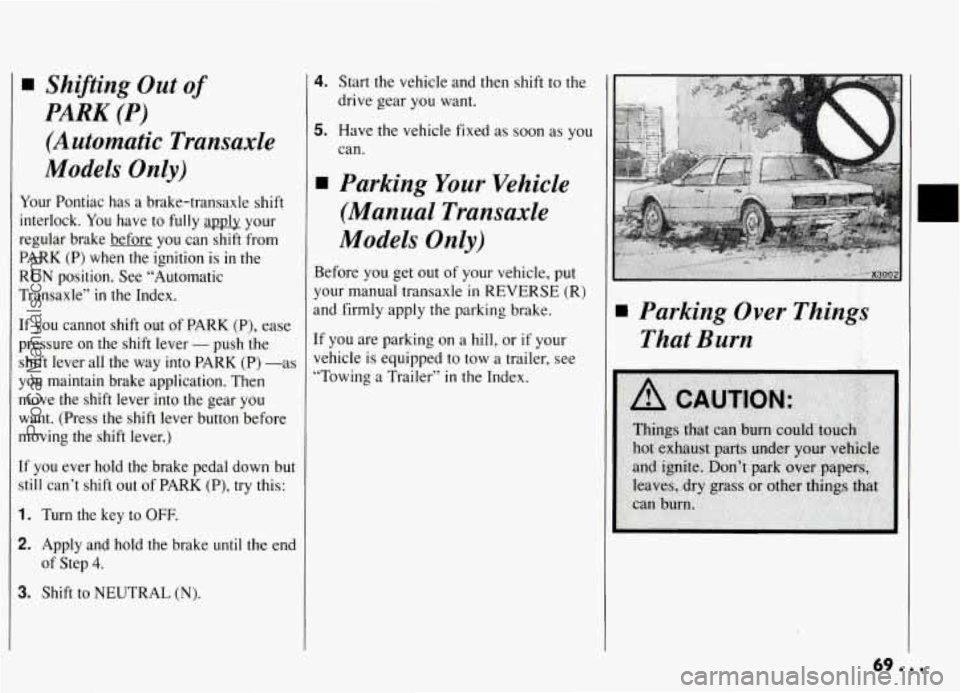
H Shifting Out of
PARK (P)
(Automatic Transaxle
Models Only)
Your Pontiac has a brake-transaxle shift
interlock. You have to
fully apply your
regular brake before you can shift from
PARK
(P) when the ignition is in the
RUN position. See “Automatic
Transaxle”
in the Index.
tf you cannot shift out of PARK (P), ease
pressure on the shift lever
- push the
shift lever all the way into PARK (P) -as
you maintain brake application. Then
move the shift lever into the gear you
want. (Press the
shift lever button before
moving the shift lever.)
[f you ever hold the brake pedal down but
still can’t shift out of PARK (P), try this:
1. Turn the key to OFF.
2. Apply and hold the brake until the end
of Step 4.
3. Shift to NEUTRAL (N).
4. Start the vehicle and then shift to the
drive gear you want.
5. Have the vehicle fixed as soon as you
can.
Parking Your Vehicle
(Manual Transaxle
Models Only)
Before you get out of your vehicle, put
your manual transaxle
in REVERSE (R)
and firmly apply the parking brake.
If you are parking on a hill, or if your
vehicle is equipped to tow a trailer, see
“Towing a Trailer”
in the Index.
Parking Over Things
That Burn
ProCarManuals.com
Page 73 of 274
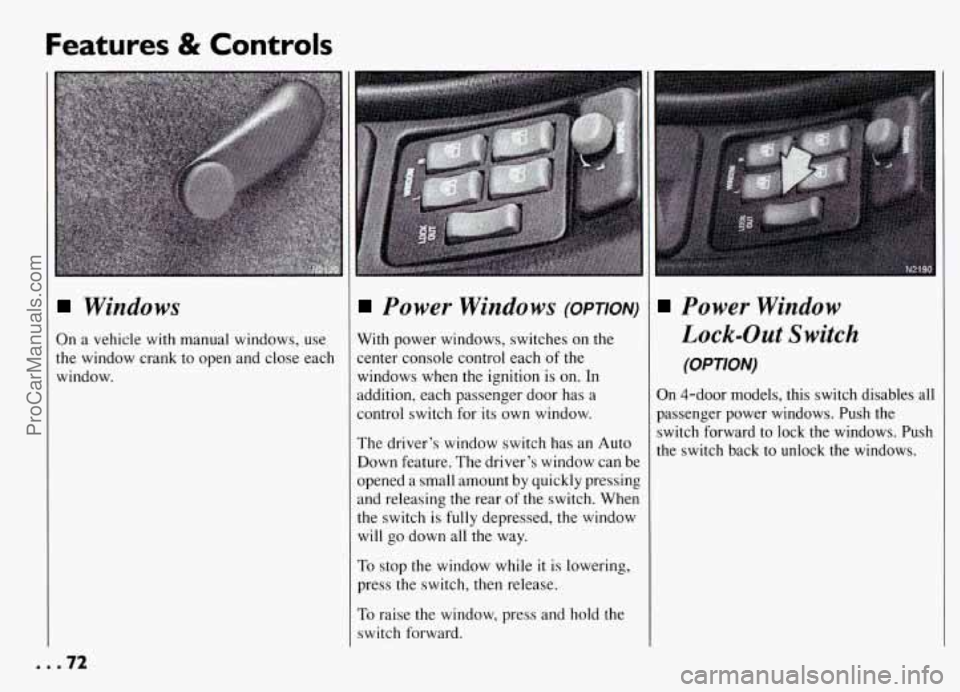
Features & Controls
Windows
On a vehicle with manual windows, use
the window crank to open and close each
window.
Power Windows (OPTION)
With power windows, switches on the
center console control each of the
windows when the ignition is on. In
addition, each passenger door has a
control switch for its own window.
The driver’s window switch has an Auto
Down feature. The driver’s window can be
opened a small amount
by quickly pressing
and releasing the rear
of the switch. When
the switch is fully depressed, the window
will go down all the way.
To stop the window while it is lowering,
press the switch, then release.
To raise the window, press and hold the
switch forward.
Power Window
Lock-Out Switch
(OPTION)
On 4-door models, this switch disables all
passenger power windows.
Push the
switch forward to lock the windows. Push
the switch back to unlock the windows.
... 72
ProCarManuals.com
Page 77 of 274
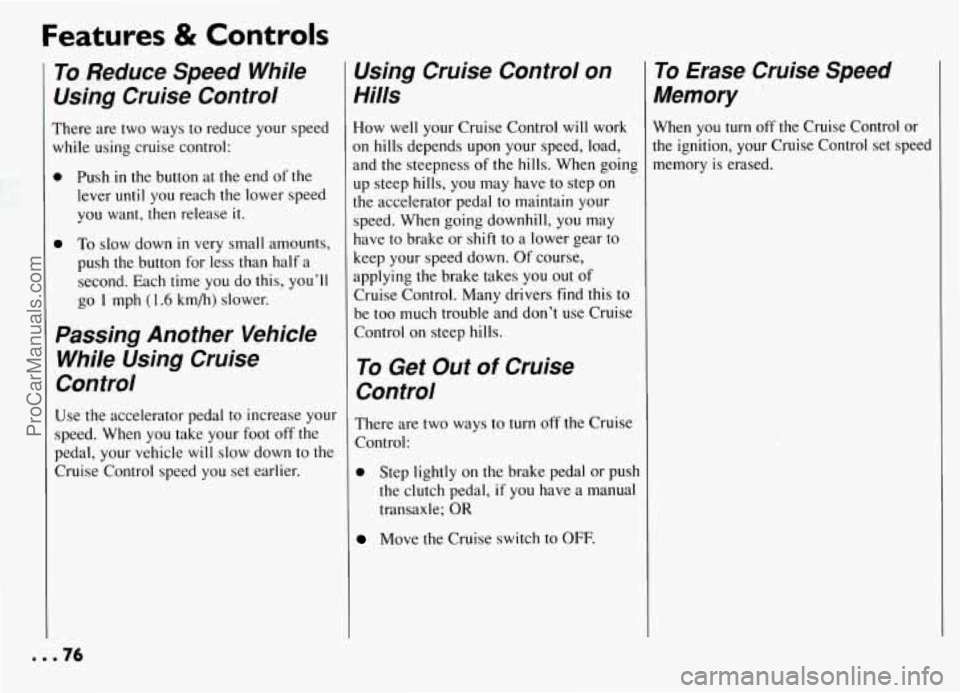
Features & Controls
To Reduce Speed While
Using Cruise Control
There are two ways to reduce your speed
while using cruise control:
0 Push in the button at the end of the
lever until you reach the lower speed
you want, then release
it.
0 To slow down in very small amounts,
push the button for less than half a
second. Each
time you do this, you’ll
go
1 mph (1.6 km/h) slower.
Passing Another Vehicle
While Using Cruise
Control
Use the accelerator pedal to increase your
speed. When you take your foot off the
pedal, your vehicle
will slow down to the
Cruise Control speed you set earlier.
Using Cruise Control on
Hills
How well your Cruise Control will work
on hills depends upon your speed, load,
and the steepness of the hills. When going
up steep hills, you may have to step on
the accelerator pedal to maintain your
speed. When going downhill, you may
have to brake or shift to
a lower gear to
keep your speed down. Of course,
applying the brake takes you out of
Cruise Control. Many drivers find this
to
be too much trouble and don’t use Cruise
Control on steep hills.
To Get Out of Cruise
Control
There are two ways to turn off the Cruise
Control:
0 Step lightly on the brake pedal or push
the clutch pedal,
if you have a manual
transaxle;
OR
Move the Cruise switch to OFF.
To Erase Cruise Speed
Memory
When you turn off the Cruise Control or
the ignition, your Cruise Control set speed
memory
is erased.
ProCarManuals.com
Page 78 of 274
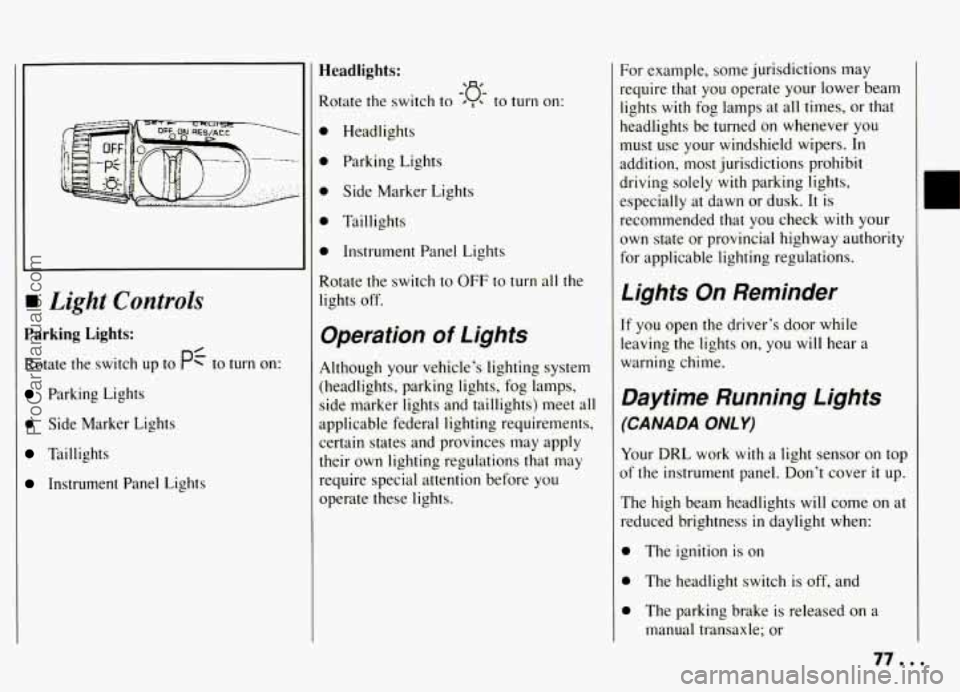
rn Light Controls
Parking Lights:
Rotate the switch up to PC to turn on:
Parking Lights
0 Side Marker Lights
Taillights
Instrument Panel Lights
Headlights:
Rotate the switch to ’ , to turn on:
0 Headlights
0 Parking Lights
0 Side Marker Lights
0 Taillights
0 Instrument Panel Lights
Rotate the switch
to OFF to turn all the
lights off.
-‘a-
Operation of Lights
Although your vehicle’s lighting system
(headlights, parking lights, fog lamps,
side marker lights and taillights)
meet all
applicable federal lighting requirements,
certain states and provinces may apply
their own lighting regulations that may
require special attention before you
operate these lights.
For example, some jurisdictions may
require that you operate your lower beam
lights with fog lamps at all times, or that
headlights be turned
on whenever you
must use your windshield wipers.
In
addition, most jurisdictions prohibit
driving solely with parking lights,
especially at dawn or dusk.
It is
recommended that you check with your
own state or provincial highway authority
for applicable lighting regulations.
Lights On Reminder
If you open the driver’s door while
leaving the lights
on, you will hear a
warning chime.
Daytime Running Lights
(CANADA ONLY)
Your DRL work with a light sensor on top
of the instrument panel. Don’t cover
it up.
The high beam headlights will come
on at
reduced brightness in daylight when:
0 The ignition is on
0 The headlight switch is off, and
0 The parking brake is released on a
manual transaxle; or
77 a I
ProCarManuals.com
Page 79 of 274
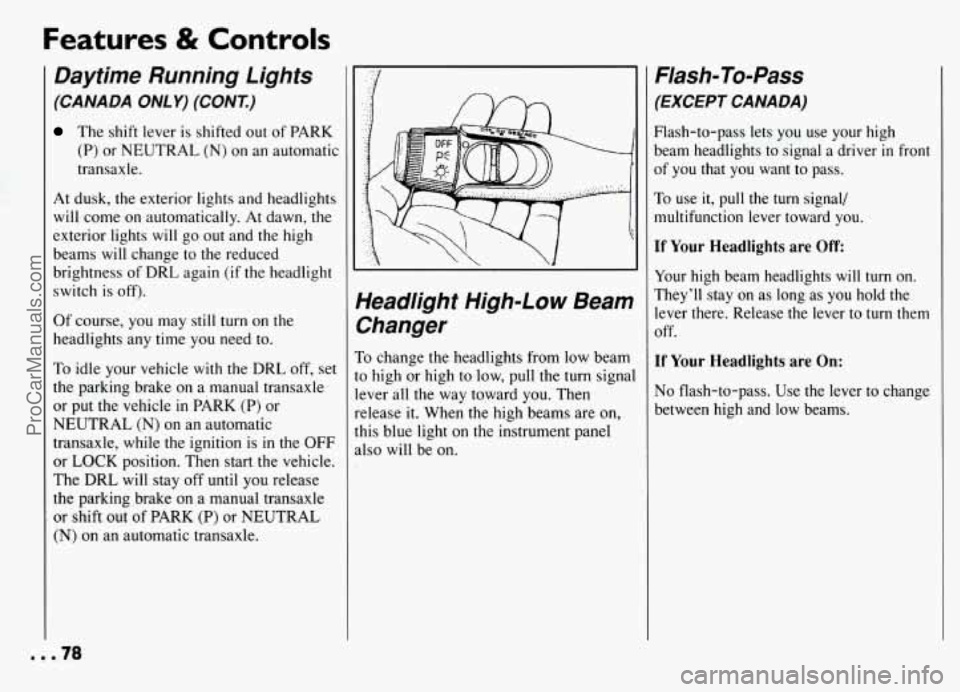
Features & Controls
Daytime Running Lights
(CANADA ONLY) (CONT.)
The shift lever is shifted out of PARK
(P) or NEUTRAL (N) on an automatic
transaxle.
At dusk, the exterior lights and headlights
will come on automatically. At dawn, the
exterior lights will go out and the high
beams will change to the reduced
brightness of DRL again (if the headlight
switch is off).
Of course, you may still turn on the
headlights any time you need to.
To idle your vehicle with the DRL off, set
the parking brake
on a manual transaxle
or put the vehicle
in PARK (P) or
NEUTRAL
(N) on an automatic
transaxle, while the ignition is in the OFF
or LOCK position. Then start the vehicle.
The DRL will stay off until
you release
the parking brake on a manual transaxle
or shift out of PARK (P) or NEUTRAL
(N) on an automatic transaxle.
Yeadlight High-Low Beam
%anger
To change the headlights from low beam
o high or high to low, pull the turn signal
ever all the way toward you. Then
elease it. When the high beams are on,
his blue light on the instrument panel
dso will be on.
Flash-To-Pass
(EXCEPT CANADA)
Flash-to-pass lets you use your high
beam headlights to signal a driver
in front
of you that you want to pass.
To use it, pull the turn signal/
multifunction lever toward you.
If Your Headlights are Off
Your high beam headlights will turn on.
They’ll stay on as long as you hold the
lever there. Release the lever to turn them
off.
If Your Headlights are On:
No flash-to-pass. Use the lever to change
between high and low beams.
mm.78
ProCarManuals.com